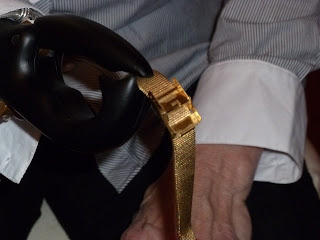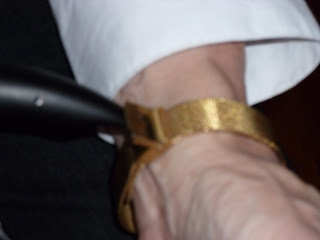Without a prosthesis:
First the traditional buckle style watchband:
Positioning is important for my success. I wear my watch on my left wrist and will typically support my left forearm on my left thigh to stabilize the area so that I can best maneuver my residual limb. I 'grasp' the watch with the crook of my right elbow and position the watch on my wrist.
Then I manipulate the band so that I will be able to feed the end into the buckle.
Once it is through the buckle, I pull it the remainder of the way using the terminal end of my residual limb and my left thigh.
I use my residual limb to push the strap though the placement holders once through the buckle
so the watch is completely fastened.
And now the double hinge metallic strap:
Again, positioning is a key to sucess. I drape the watch over my wrist using my residual limb. My left forearm is supported on my thigh to stabilize my arm during the task.
I align the strap onto the prongs of the clasp
and use my residual limb to push the clasp and hook it together
Then I push the second hinge over the first in the same fashion
And it's on!
With a prosthesis:
The traditional buckle watchstrap:
I drape the watch on my wrist, pinch the strap, push and then pinch and pull it to get it through the buckle.
And finally the double hinge watchstrap:
I grasp the watch with the terminal device and position it on my wrist.
I line up the hooks on the clasp and then pinch
Then I fold over the second hinge and repeat the process
And the watch is on.
I must confess that photographs give the appearance of simplicity. I have spent many hours practicing these techniques, beginning when I was very young. Don't be discouraged... any skill worth acquiring is worth working toward with diligence! And being maximally functionally independent is a worthy goal.
Next to be published will be buttoning the cuff button ... Check back next week!!
In the meantime, be well, be blessed.



























Debi,
ReplyDeleteJust wanted to say thanks so much for your blog! Today, a little boy in a small village in Niger (west Africa) learned how to tie his shoes with just his left hand . . . thanks to your shoe-tying post.
I'm an Occupational Therapist in a hospital in the village of Galmi. I have an 11 year old patient who is about to lose his right hand from the wrist down . . . pretty tough in a culture where the left is considered 'unclean'. The best part is, he goes to school. In a country where 10-15% of the population are literate, this is huge. So we've been working on handwriting skills, and today was shoe tying, as his school uniform includes closed shoes.
So thank you! Please keep the posts coming!
Deb.